Tim Mathis's Blog, page 3
October 14, 2023
Viladesuso to Vigo: Portuguese Coastal Camino Day 8
<< Back to Caminha to Viladesuso: Portuguese Coastal Camino Day 7
Forward to Vigo to Cesantes: Portuguese Coastal Camino Day 9 >>
In this introduction to the stages of the Portuguese Coastal Camino, I'm focusing on the stuff you actually need to know. You'll sort out accommodation and restaurants and so forth on your own as you travel. I'll cover the things that you don't want to miss along the way. For everything else, check out this article: What do you REALLY need to know about the Portuguese Coastal Camino?
 A rundown of the Portuguese Coastal Camino: Viladesuso to VigoDistance
A rundown of the Portuguese Coastal Camino: Viladesuso to VigoDistance40.4 km/25.1 miles
TerrainAn epic stretch of roads, cobblestones, beaches and city sidewalks. A lot of ups and downs, but no major single climbs or descents.
ExperienceListen, you probably don't want to do this stage like this. I didn't actually do this stage like this. I walked from Viladesuso to the beaches south of Vigo and took a taxi into the central city. If you walked the whole way it would be epic and beautiful but a really long day.
Also don’t do it because if you do you’ll be blasting through some really pleasant places. Break this stage up into a few days if you can. There's no reason you can't. You could stay in Baiona or Ramallosa or Nigrán and have a great time. Take a day off and go to the Cies Islands. There are a lot of options here.
Having said that, the 20 miles or so that I did walk of this section were one of my favorite stretches of the Camino. It's varied, beautiful, and full of history and culture.
The first part of the stage out of Viladesuso is great, even if it is more road walking. It's a super pretty stretch of coast. Then you cut in from the ocean and over a hill which gives you great views to Baiona from a stretch of rural walkway.
Baiona is one of the most picturesque cities on any Camino, and personally this is when I officially started to fall in love with this route. Everything before had been beautiful, and I’d heard it just gets better through the Spiritual Variant, so I realized the whole route was going to be amazing.
Baiona is small enough that it manages to maintain it's historic fishing village vibes, but it's big enough to pull off the Euro winding cobblestone street thing as well. You should probably just stop here. Wander the old town. See the 11th century Monterreal Fortress. (It's a luxury hotel now). Visit the parks on the peninsula where the fortress sits. Go see the 13th century Ex-Collegiate Church of Mary. It's all within easy walking distance and would make a great way to spend a day off.
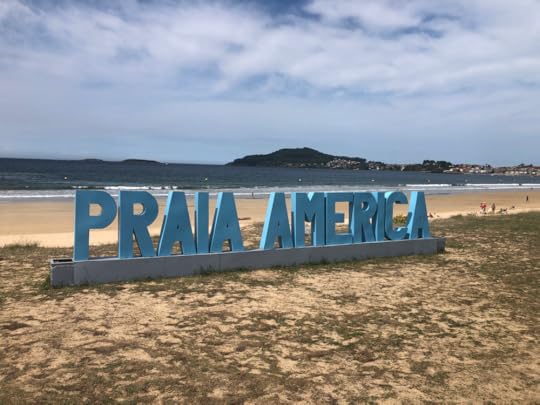
Or maybe go to the beach at Playa America and drink some Albariño. Baiona is famous as the arrival point of the Pinta - the boat from Columbus' voyage that brought news back to Europe about the existence of the Americas for the first time. In the first weekend of March they celebrate the Arrival Festival as one of their major civic events.
After Baiona, continue along the Camino through Ramallosa. There are a few urban sprawl moments but generally the walk is lovely, passing lots of old stone houses and at lease one old fountain where you can fill your water. In Ramallosa, you cross a beautiful 12th century pedestrian bridge over the Minor river into Nigrán, which is said to be one of the best preserved in Galicia.
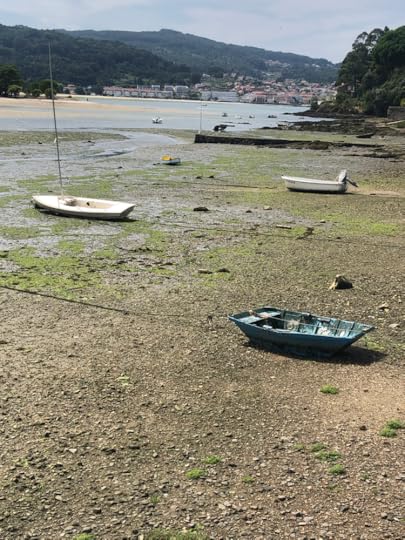
Just after the bridge, I very much recommend going left and taking the alternate, which follows along the river and beaches rather than going through town towards Vigo. You’ll pass the aforementioned golden sands of Praia America and a series of of beachside cafes. It's well marked, but I did consult my Wise Pilgrim app a few times while the alternate wound its way through city strets.
Once you get past the beaches the route takes you over a hill to a neighborhood called Patos. It’s worth using Google Maps and taking a slight detour up to the ,Iglesia de San Juan Bautista de Patos. It's one of the more picturesque and distinctive small churches you’ll pass along this Camino: not that old (1930s), but man is it pretty, inside and out. It’s only a couple minutes out of the way.
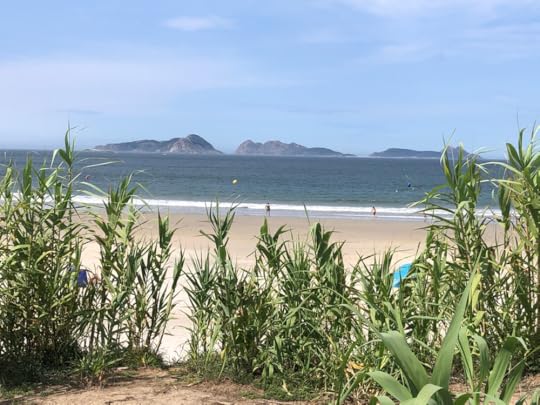
From there, the alternate goes back downhill past more beautiful beaches and coast. Sunbathers and swimmers abound. For the rest of the way into Vigo, you’ll roughly be winding along the coast, but you do go up and over a few hills on roads. You pass a lot of pretty beaches with great views of the Cies Islands the rest of the way. The road walking is a little bit tedious at times but that’s a silly thing to complain about.
There are a few albergues along this section in the beachy neighborhoods southwest of Vigo center. It’d be a sensible decision to stay in one of these if you're still walking, as this will be turning into a long day by this point.
Personally, I walked until I found a bar on a beach about 5 miles from the center of Vigo, and had a few beers. Then, I cheated and caught a taxi into the central city. I don't regret it, but it seems like the rest of the alternate would've been nice too.

I don't regret it because Vigo is a really great city, and it's a nice place to stay in the center. It has a slightly different feel than other cities along the Way, and it’s bigger and more modern than Santiago. It has plenty of history but also a lot of newer structures and art. Situated on a bay, the geography reminded me of nowhere so much as Wellington, New Zealand. It's not that popular with tourists so it feels more authentically Spanish than, for instance, Pontevedra or Baiona. The pretty Constitution Square is a great place to spend the evening. Praza Porto del Sol is also close by with a core Vigo landmark - an abstract sculpture of O Sereo - a merman/male Siren. I thought there was great nightlife in Vigo, which made it a perfect place to experience on of my personal favorite things about Spain - the kids and grandmas and families hanging out on the square together late into the night.
The Co-Cathedral of Santa Maria in old town is another church that’s well worth a stop. It's maybe Vigo’s best known building, and even though it was only built in the 1800s it reeks of civic history. The Cathedral houses the famous Christ of Victory sculpture. The origins of the sculpture are shrouded in legend, but there's some consensus that it was thrown into the sea and gathered up by a passing ship before being taken to Vigo. It's unclear whether there’s any truth to this story but these little legends are a great bit of the Camino experience. Vigo's most important festival kicks off on the first Sunday in August, and involves a massive procession behind the sculpture, which is taken from the cathedral and paraded through town.
A quick note about the Cies IslandsVigo is also the place to be if you want to take a side trip to the ,Cies Islands. A maritime national park, the islands are meant to be some of the most beautiful and pristine in Spain, and a fair number of pilgrims factor in an extra day to visit them along the Way. Getting there is actually a bit tricky, and requires either a fair bit of pre-planning or a private booking when a tour happens to be running (usually on weekends). We didn't make it, but a lot of people list it as a highlight of the trip. Seems like it would be worth the effort. This website gives a rundown of the process involved in getting there.
<< Back to Caminha to Viladesuso: Portuguese Coastal Camino Day 7
Forward to Vigo to Cesantes: Portuguese Coastal Camino Day 9 >>
Caminha to Viladesuso: Portuguese Coastal Camino Day 7
<< Back to Viana do Castelo to Caminha: Portuguese Coastal Camino Day 6
Forward to Viladesuso to Vigo: Portuguese Coastal Camino Day 8 >>
In this introduction to the stages of the Portuguese Coastal Camino, I'm focusing on the stuff you actually need to know. You'll sort out accommodation and restaurants and so forth on your own as you travel. I'll cover the things that you don't want to miss along the way. For everything else, check out this article: What do you REALLY need to know about the Portuguese Coastal Camino?
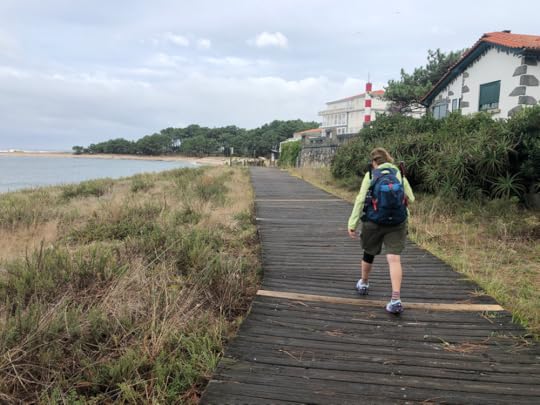 A rundown of the Portuguese Coastal Camino: Caminha to ViladesusoDistance
A rundown of the Portuguese Coastal Camino: Caminha to ViladesusoDistance23.3 km/14.5 miles
 Terrain
TerrainAfter you get off the boat in Spain at Camposancos, most will walk up and over a hill a few km into A Guarda. However, you also can trace the coast for a prettier but significantly longer option (it adds about 4 km/2.5 miles). The road is flat to rolling the rest of the day. You follow some really stunning coastline, though for a lot of the time you'll be on a separated path on the side of a highway. There’s a separated walkway so don’t stress about safety or anything.
2 Notes:
1) If you didn't catch the instructions on how to catch the water taxi from Caminha, I explain it in the previous post.
2) Don't forget to shift your clocks ahead an hour. Spain is on a different timezone from Portugal.
ExperienceThis first day of walking in Spain is muy tranquilo. The ride across the Minho is really pretty, even if the taxi does dump you unceremoniously on a beach a few kilometers from town, leaving you to work your way up and over a hill into A Guarda.
A Guarda is a beautiful little town on a peninsula with nice cafes and a square with a nice old church. We didn't stop by, but it's also the sight of an old Celtic fort from pre-Roman days. The walk out of town is gorgeous, with views along the coast and then mixed road and trail. If you're keen for town time today, spend it here because there aren't any more settlements of any size the rest of this stage.
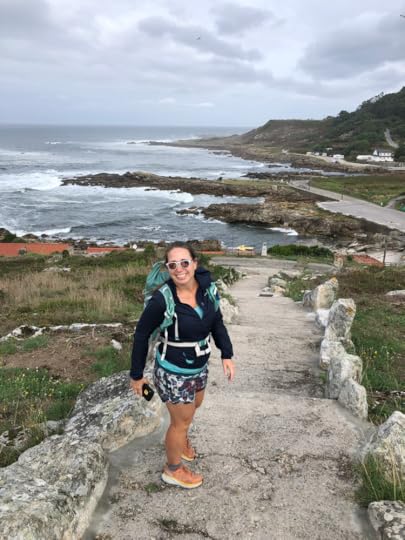
The coast here is stunning but much of the day involves walking on the side of the road. Road walking isn’t that great but it is what it is. To me, it felt like I'd imagine it would feel to walk Highway 1 in Northern California, if it were much less busy. Gorgeous, but also it's blacktop. It goes fast and it's not too painful, and there are plenty of nice if not notable roadside cafes along the way to break things up.

Oia is a beautiful little agricultural village with a 12th century monastery right on the coast. It's a nice place to stay, which is why more pilgrims stay here than continue on to the serviceable but less atmospheric Villadesusa.

Viladesuso is a more modern coastal development with the roadside Hotel Glasgow being the most visible structure. It's no 12th century monastery. Still, even if this is a sleepy little spot, it's not a terrible place to spend an evening. We had one of our best sunset views of the Camino there in a nondescript bar, drinking cheap Spanish lager.
<< Back to Viana do Castelo to Caminha: Portuguese Coastal Camino Day 6
Forward to Viladesuso to Vigo: Portuguese Coastal Camino Day 8 >>
October 12, 2023
Viana do Castelo to Caminha: Portuguese Coastal Camino Day 6
<< Back to Antas to Viana do Castelo: Portuguese Coastal Camino Day 5
In this introduction to the stages of the Portuguese Coastal Camino, I'm focusing on the stuff you actually need to know. You'll sort out accommodation and restaurants and so forth on your own as you travel. I'll cover the things that you don't want to miss along the way. For everything else, check out this article: What do you REALLY need to know about the Portuguese Coastal Camino?
 A rundown of the Portuguese Coastal Camino: Viana do Castelo to CaminhaDistance
A rundown of the Portuguese Coastal Camino: Viana do Castelo to CaminhaDistance27 km/16.75 miles
TerrainSome general urban road walking out of Viana do Castelo, then a mix of cobblestones, narrow lanes, boardwalks and nice rural paths. Nothing too notable in terms of climbs or descents though there's a bit of up and down through the day.
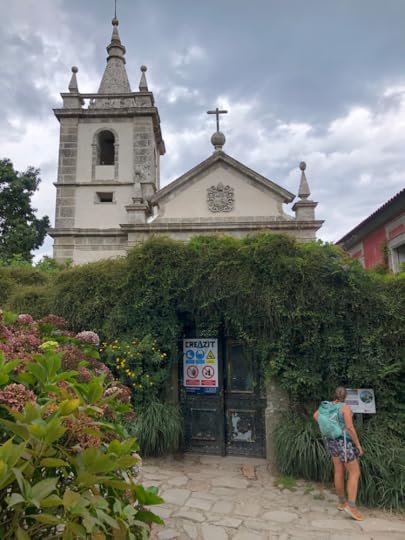 Experience
ExperienceAnd just like that, you're on your last stage before leaving Portugal - assuming you stick to the Coastal Route like we did. (After this stage, a lot of people follow the river from Caminha to Tui, and connect with the Central Portuguese Camino. There's no reason to do that though - the Coastal Route in Spain is just as beautiful, if not more so, than it was in Portugal.)
My photos from this stage are lackluster because it started to rain on us in the afternoon, and I didn't get out my camera. It actually is another very nice stage though, once you make it through the outskirts of Viana do Castelo (which are disappointingly industrial after the very pleasant introduction to the city on the prior stage). If you follow the Senda Litoral/Coastal path, for most of the day you'll be on flat terrain, along nice coastline, through pleasant towns until you get to Caminha, a beautiful, historic town on the mouth of the Minha River.
During the first part of the day, you'll pass forts and windmills, and the serviceable little towns of Areosa and Carreco.
Vila Praia de Ancora is quite a pretty little seaside village with a nice chapel and a pleasant square.
If you take a small detour between the town of Ancora and the Praia you can see the Anta da Barrosa - a genuinely old structure - a monument from the 30th (?!) century BC. It's a stone monolith - think a small stonehenge with a granite roof - and you'll see signs in the area with its image.
The way involves really beautiful coastal walking after this. To me, you're starting to feel the proximity to Galicia at this stage. It's all green and ferns and cattle enjoying nice coastal views.
The stage ends at Caminha - a nice town at the mouth of the Minha River with a lot of history. The Igreja de Misericordia here has been serving pilgrims as a chapel and hospital since the 16th century. The exterior is nondescript but go in if you have the opportunity. The interior is ornate.
Nearby in the town center is an old castle keep - you can't miss it. The area was fortified against invaders in the 12th century, and this old structure is now a clock tower. Caminha's pretty main square is a great place for dinner or beers, with a 15th century fountain and the castle tower adding an air of romance to the experience. It all feels like a scene out of Beauty and the Beast or something.
You've made it to the mouth of the Minha, which is a significant location in both Spanish and Portuguese history, serving as the border between the countries. In the morning, if you continue on the Coastal Way, you'll cross the river by boat and notice the prominent fort built on an island in the middle of the river. Monks lived there as early as the 14th century. The fort built in the 17th to protect the river during the age of conquest.
 Catching the boat across the Minho River from Caminha to A Guarda
Catching the boat across the Minho River from Caminha to A GuardaIf you're like most, you'll be anxious to sort out how to arrange a boat across the river from Caminha to A Guarda for the next stage.
Most people coordinate this when they arrive in Caminha because the timetables fluctuate with the tide, and it's a small, relatively informal operation. If you're staying in an albergue, just ask the host and they can help. They do this every day, and can give advice on timetables as well as transport to the water taxi, which leaves from outside of the town center.
It is also possible to arrange a ride yourself if you want. At time of writing the company serving pilgrims is called Taxi-Mar and they have a website with contact information.
I won't quote a price here because these things change, but it was very affordable. And as far as I know, they don't sell out - they simply keep making trips until everyone is across. It's probably worth calling ahead if you're planning to cross in low season, because it's a small operation.
The trip takes about 15 minutes, features great views up the Minho and out to the Atlantic, and leaves you on a beach where you can connect back to the Camino in Spain. It's a nice little adventure as you say goodbye to Portugal.
<< Back to Antas to Viana do Castelo: Portuguese Coastal Camino Day 5
Antas to Viana do Castelo: Portuguese Coastal Camino Day 5
<< Back to Apulia to Antas: Portuguese Coastal Camino Day 4
In this introduction to the stages of the Portuguese Coastal Camino, I'm focusing on the stuff you actually need to know. You'll sort out accommodation and restaurants and so forth on your own as you travel. I'll cover the things that you don't want to miss along the way. For everything else, check out this article: What do you REALLY need to know about the Portuguese Coastal Camino?
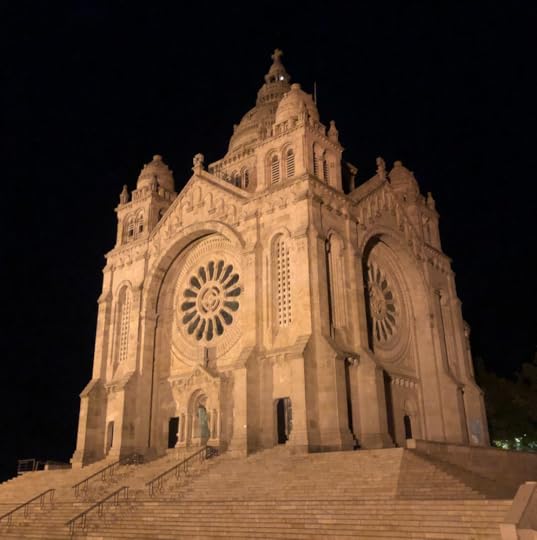 A rundown of the Portuguese Coastal Camino: Antas to Viana do CasteloDistance
A rundown of the Portuguese Coastal Camino: Antas to Viana do CasteloDistance16.8 km/10.4 miles
TerrainPrimarily paved road, sidewalk and cobblestones with a bit of trail mixed in. About 3 km into the stage, there's a road section up to Castelo do Neiva that feels like an actual climb! A rarity thus far on the Coastal Camino! It's worth it because it's maybe the most interesting day thus far. You'll be on a lot of forest trail and cobblestone today. Some find that difficult. I like it, personally.
 Experience
ExperienceThe stretch between Antas and Viana do Castelo is great. It's really starting to feel like a Camino.
The Way out of Antas takes you through pleasant wooded scenery, dirt trail and rural villas, and across a narrow stone bridge before sending you up a hill towards Castelo de Neiva. It's the first time on this whole Camino that it feels like you're climbing. You follow a road and veer inland for a time, moving a bit away from the coast.
The Santiago Church at the top of the climb is really remarkable. It's the site of the first evidence of veneration of Santiago outside of the Minho River valley (which we’re moving towards), and was dedicated in 9th century. They have an exposed stone where this dedication/inscription was rediscovered during a refurbishment. Go in. Have a look at 1200 year old writing. It's a great place to sit and absorb history. There's a nice modern chapel here as well. Evidence of the Camino's impact can be a little bit less visible earlier in the Portuguese Camino, but here you're thrown right into the ancient history of it all.

You continue for a while through cobblestones and forest paths, before descending into Chafé, as perfectly named a Camino town as you'll find.
From Chafé you continue a few rural kilometers to Anha, where you can visit another chapel dedicated to Santiago (18th century) before continuing for another hour or so to the bridge over the Rio Lima into Viana do Castelo. This bridge was designed by Gustav Eiffel, of Eiffel Tower fame. I didn't take a picture because 1) it's not actually that remarkable to look at, and 2) I didn't realized it was an Eiffel structure until after we'd left town!
Also, I was probably looking up towards the temple on the hill in Viana do Castelo when we were crossing the bridge. It's maybe the most iconic structure you'll see between Porto and Santiago. It's relatively new, built in the early 1900s, but really beautiful, inside and out.
I included a photo at the top of this post, but it's hard not to include multiple shots.

Viana do Castelo is a really great town, and it presents you with a dilemma. You can stay in the old town in the central city, close to pretty old squares, a nice modern mall, and a beautiful river mouth. Or, you can climb 600 stairs (or pay to take a frankly overpriced funicular) to the top of the hill by the temple and stay in the Albergue de Santa Luzia, adjacent to the temple and maybe the most spectacularly situated albergue on any Camino.

We decided to wander the town when we arrived in the afternoon, eat a snack at a bar, and cook dinner at the albergue at the top of the hill. I think it was the right choice, because it gave us the chance to watch the sunset over the ocean from the hill, and to have the Temple mostly to ourselves after dark. It made for a magical evening.
If you decide to do the same, stop in at the Igreja da Misericórdia before you head up the hill. It's one of the most spectacular church interiors you'll encounter on this Camino, with quintessential Portugese tile work.
There's a lot here, so if you're feeling tired, Viana do Castelo would be a great place to spend a rest day.
<< Back to Apulia to Antas: Portuguese Coastal Camino Day 4
Forward to Viana do Castelo to Caminha: Portuguese Coastal Camino Day 6 >>
October 5, 2023
Apulia to Antas: Portuguese Coastal Camino Day 4
<< Back to Day 3: Vila do Conde to Apulia
In this introduction to the stages of the Portuguese Coastal Camino, I'm focusing on the stuff you actually need to know. You'll sort out accommodation and restaurants and so forth on your own as you travel. I'll cover the things that you don't want to miss along the way. For everything else, check out this article: What do you REALLY need to know about the Portuguese Coastal Camino?
 A rundown of the Portuguese Coastal Camino: Apulia to AntasDistance
A rundown of the Portuguese Coastal Camino: Apulia to AntasDistance15.2 km/9.5 miles
TerrainBeachside boardwalk and cobblestones, mainly. Fao and Esposende are nice town stops along the way. For the first time you experience something approaching a climb after Marinhas midway through the stage, and veer a little bit away from the ocean.
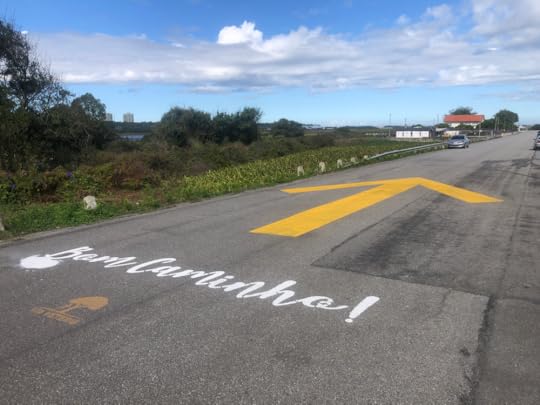 Experience
ExperienceThis is a short stage if you follow our itinerary. Most people don't, but that's fine. Antas only has a private guesthouse so it's not a common place to stay. The guesthouse is very nice, if not necessarily cheap.
You'll start the day on boardwalk along the coast passing a series of old stone windmills, which is nice.

Fao and Esposende both offer the opportunity to stop for coffee and wander a bit in town. In Fao there's a 16th century church worth visiting - Santa Casa Misericordia. Esposende is a bit larger of a town with a pretty coastline and the very visible São João Batista Fort, with its red lighthouse - another 16th century structure. Either town would make a nice place to stay the night.
Stop here or in Marinhas just up the way to appreciate the coast - you'll cut inland for a day's walk or so after this so it's a last chance for a swim for awhile if that's your thing.

You'll pass through a series of small villages, and have the chance to visit a series of nice chapels across the day, as per usual.

I feel like there should be more to say, but it's just another stage of more cruisy walking on the Coastal Camino, bouncing between beaches and villages and cafes and chapels.
Vila do Conde to Apulia: Portuguese Coastal Camino Day 3
<<Back to Day 2: Matosinhos to Vila do Conde
In this introduction to the stages of the Portuguese Coastal Camino, I'm focusing on the stuff you actually need to know. You'll sort out accommodation and restaurants and so forth on your own as you travel. I'll cover the things that you don't want to miss along the way. For everything else, check out this article: What do you REALLY need to know about the Portuguese Coastal Camino?
 A rundown of the Portuguese Coastal Camino: Vila do Conde to ApuliaDistance
A rundown of the Portuguese Coastal Camino: Vila do Conde to ApuliaDistance21 km/13 Miles
TerrainBeach, boardwalk and cobblestones - mainly flat with occasional rolling hills. Nothing to stress about. Key towns are Povoa de Varzim and Agucadoura but restaurants and cafes are dispersed every few miles today. Lots of nice coastal views. It's lovely.
ExperienceIf you follow the Senda Litoral, the day starts by heading straight to the coast through Vila do Conde. If you haven't yet, take some time to wander the streets in town and see the old town. It's a gorgeous little place. You'll have the option to follow a more traditional route through the suburbs instead of along the coast, but by all accounts, it's better to walk along the water. That's what we did, and we liked it.
Povoa de Varzim is a popular beach resort town about 4 km from Vila do Conde. It's worth a cafe stop, and wander as well. There are some cool old churches, narrow streets, and nice tile facades characteristic of the area.

The Capela de Sao Roque on the square in Povoa de Varzim is a stately structure with an ornate interior that features some characteristic Portuguese tile work. It's worth a stop, right off the Camino. It's not officially dedicated to St. James, but there are old Camino connections here. The chapel grew in prominence in the 15th century when a St. James icon was said to have been found on a beach nearby and installed, and a local brotherhood dedicated to St. James was established. Now you'll find a small plaque and some scallops scattered around the structure, but I'm not sure what happened to the icon from the beach. The square here is colloquially referred to as Santiago square.
After Povoa de Varzim, the route today primarily meanders directly along the coast until after Agucadoura. Along the way, you pass some interesting and picturesque old windmills, and a lot of beautiful, relaxed coastal scenery. It captures the essence of what the Coastal Camino is about. Relaxed, pretty walking along the ocean, passing in and out of small, picturesque settlements. No worries.

When you get close to Apulia, you'll cut in from the coast slightly.
Apulia is quite a small place. We stayed in a nice little albergue here because it fit our itinerary, but a fair number continue up to Fao or Esposende. Any are good options with multiple options for accommodations and food.
October 1, 2023
Matosinhos to Vila do Conde: Portuguese Coastal Camino Day 2
In this introduction to the stages of the Portuguese Coastal Camino, I'm focusing on the stuff you actually need to know. You'll sort out accommodation and restaurants and so forth on your own as you travel. I'll cover the things that you don't want to miss along the way. For everything else, check out this article: What do you REALLY need to know about the Portuguese Coastal Camino?
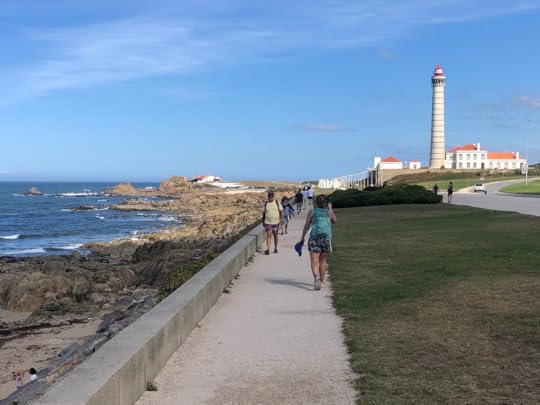 Distance
Distance 23 km/14 miles
TerrainA flat mixture of boardwalk, paved path, and cobblestones. People at the beginning of this Camino worry about walking in sand. There's no sand except for one or two very short sections (think 50 meters) where the boardwalk is damaged.
 The first day's experience on the Portuguese Coastal Camino (for most people)
The first day's experience on the Portuguese Coastal Camino (for most people)For most people on the Coastal Camino, this will be your first real stretch of walking. The first real Camino-ing. It's a good place to start. The day is a mixture of beautiful beaches where you can stop for a swim if you'd like, lovely rugged coastline, nice little towns, and a conclusion at one of the coolest towns on the Camino if Vila do Conde. If it were me, I'd book accomodation ahead to take the stress out of your first day. If you want a shorter day, Vila Chá is a great, picturesque little beach town and would make a nice place to stay the night.
You'll leave Matisinhos with a nice view of the Boa Nova Lighthouse, and will pass several old forts and chapels along the way between here and Vila Chá. As with the entire Coastal Camino, you'll pass plenty of cafes along the way for refreshments. This segment feels relatively populated as you're still in the outskirts of Porto.

After the small settlement and beaches at LaBruge, about 13 km north of Matisinhos, you'll pass the Castro de Sampaio, a chapel and archeological site. There's an interpretive center explaining the significance of the area, which was the site of an Iron Age fort.
Then you'll pass over a bridge near the sea, and a lovely view of the Onda River. It wouldn't be the worst thing in the world to stay in this area.
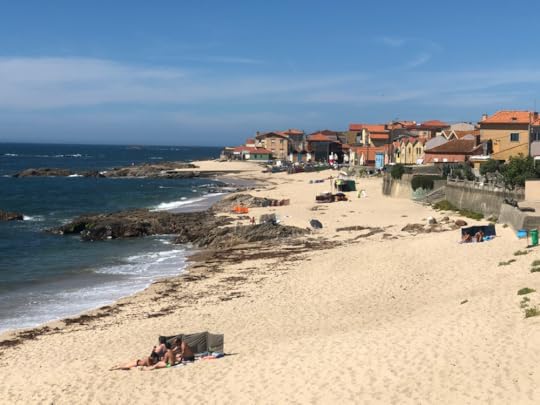
Vila Chá is just a few more kilometers, and it is also a great little town. There's a popular albergue there, and if you're walking in high season it'll be competitive to get in. Lots of people are at the height of accommodation anxiety at the start of the walk so it fills early.
It's another 8 km or so until Vila do Conde. There are cafes and bars but no other accommodations on this stretch (that I know of). It's a mix of nice coastal scenery and suburban wandering as you move into Vila do Conde, a medium city of about 80,000 people.
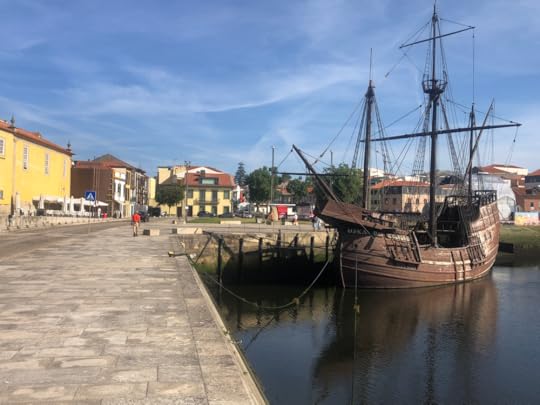
Vila do Conde is really worth some time if you have it. It must be a great place to live, because it's one of the oldest settlements in Portugal, with evidence of human habitation as early as 100,000 years ago. If you take a bit of time to explore, you can visit a 14th century church on the grounds of the Convent of Sta. Clara - the large, white structure you can't miss as you come into town across the bridge. There's also a striking 17th century aquaduct and a host of old churches and buildings from the 16th and 17th centuries.

There's also a bit of interesting Camino history here. The town grew up during the "Age of Discovery" as Portugal and other maritime powers in Europe were colonizing the world, and was an important seaport in that era. However, it's said that development really boomed in the city when King Manuel I passed through on his pilgrimage to Santiago, and decided to invest in the area.
From the start, you can see how the Camino has shaped this part of the planet for centuries.
Back home to What do you REALLY need to know about the Portuguese Coastal Camino?
September 27, 2023
Porto to Matosinhos: The Start of the Portuguese Coastal Camino
Distance: 11 Km
So, you’re starting your walk on the Portuguese Coastal Camino? If you’re like most, your starting point is going to be Porto.
There’s no particular historical reason to start at Porto, as far as I can tell. It's an important city that pilgrims have been passing through on their way to Santiago since at least the 10th century, but there's no other connection to St. James mythology. As far as I know there’s not even a Catholic church dedicated to Santiago in Porto - although there is, interestingly enough, an old ,Anglican Church of St. James that’s worth a look.
Never mind history though, Porto is a fantastic place to start your walk. It feels like the right place to start an epic journey. It’s convenient to get to, atmospheric, and worthy of the trip to Europe all on its own. Tradition builds over time, and you’re a part of the process of making Porto an important destination on this ancient pilgrimage trail.
If you fly in, the airport is small and easy to navigate, and there’s a convenient and affordable metro train that you can take into central Porto.
 Porto as the start of your Camino
Porto as the start of your CaminoIt can seem like the Portuguese Coastal Camino is a relatively new route, because in recent years it’s regained popularity among modern travelers, and has become a nice alternative to the busier ,Camino Frances. However, the route actually dates back to the Middle Ages, and first became an important pilgrimage and commerce route in the 12th Century. You’ll find that a lot of the Camino infrastructure along the way is new and modern, but people have been walking this way for centuries.
Most people consider the start of the Coastal Camino to be the ,Sé Cathedral do Porto in the center of the old city. The Cathedral is one of the most important and impressive buildings in Porto. It’s a great place to start your immersion and get your first stamp along the Way to Santiago. It’s also well worth the cost to pay the small fee for entry to visit the grounds and get some great views of the city.
It’d be a shame to rush out of Porto from there there. If you have the time, spend a few days, eat some Francesinhas, drink some port and vino verde, and see the sights. You’re probably going to need to beat jetlag anyway. Do it here, in a really stunning European city.
Our strategy was to book a few nights of accommodation at ,Albergue de Peregrinos do Porto and wander the streets before we started the trip. There are plenty of accommodation options, but that albergue was a great, central landing spot that makes it easy on pilgrims at the start of their journey.
 Don't skip the Camino between Porto and Matosinhos
Don't skip the Camino between Porto and MatosinhosOn one of our days in Porto, we walked a short section of the Camino from the Cathedral and Matosinhos, then took the local metro back to our accommodation in the city. Some pilgrims skip this section, but I’m not sure why you’d want to. It’s a nice, flat walk along the river Douro with great views and nice swimming beaches when you get to the coast. It is a nice way to get your feet wet with an easy day walk while also seeing the city. At about 7 miles you can integrate it into a bigger day of sightseeing. Even if you weren't doing the Camino, this would be a great way to spend a day in Porto.
 How to spend a few days in Porto
How to spend a few days in PortoWith the rest of our time, we generally just did chores and wandered. If you need to buy gear, there’s a ,Decathlon within easy walking distance of the Albergue de Peregrinos where we picked up hiking poles. We also stopped in a Vodafone shop and got local SIM cards so we’d have phone service. (Make sure to ask for a plan that will work in both Portugal and Spain if you’re going all the way to Santiago!)
Porto is a city full of parks and narrow streets and nice restaurants and beautiful views. We happened upon a book fair at the ,Jardim do Palacio de Cristal, which is a lovely garden with great views of the river at sunset. The city is a vibrant place. Along with the book fair, we happened upon a breakdancing competition and a music festival, alongside a ton of street musicians and general urban life. It’s a great city to just wander for a few days.
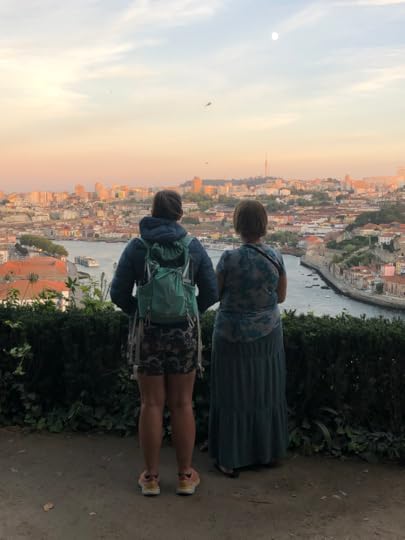
Gathering in a crowd to watch the sunset has become a Porto tradition, and it really is spectacular over the river and out towards the sea. There are ,a lot of places in town to get a good view, but the most people gather either on the very visible, very pretty Luis I Bridge, or just nearby in ,Jardim do Morro. It’s not a Camino tradition, per se, but a Porto sunset, followed by a nice meal and some local vino verde really is a great way to start your journey.
A lot of people go to the ,Livraria Lello - “The most beautiful bookstore in the world,” and a place that people have claimed inspired the wizarding shop in Harry Potter. J.K. Rowling denies it. We didn’t go because it’s a whole thing - you have to book ahead and pay for entry. We did, however, pop in “,The most beautiful McDonalds in the world,” which is also nearby.
You can easily spend a day just wandering in the old central city, taking photographs of Porto’s distinctive tile facades, eating pasteles de nata and other local treats. It’s easy to fall in love with the food in Portugal straight away. The bakeries are amazing, and you really should try to find a local spot and order a ,francesinha. It’s hearty.
If you have time, it’s also worth walking across the Luis I Bridge to the other side of the Douro from Porto, to Vila Nova de Gaia. There’s a nice market on the river and a beautiful old monastery on the hill.
Before you start your Camino, take some time, see the sights, get over jetlag. Porto is a fantastic place to start. No matter how much time you have there, you’ll be sad to go.
When you do leave town, the route is straightforward. It’s marked intermittently with arrows and scallop shells, but it doesn’t really matter. You just go down to the river, hang a right and walk to the sea. There are cafes and other services along the way, and ,Matosinhos is a great little town in its own right with plenty to do if you want to take some time exploring.
Back to Everything You Really Need to Know about The Coastal Camino
September 24, 2023
What do you REALLY need to know about the Portuguese Coastal Camino?
 All of the information you really need to know about the Coastal Camino de Santiago, in a tight little package.
All of the information you really need to know about the Coastal Camino de Santiago, in a tight little package.There’s a lot of information on the internet. Some of it’s useful, some of it’s not. That’s as true of the Camino de Santiago as of anything. As we speak, armies of digital nomads are pumpiing out blog posts to boost SEO and run ads and make money to continue their travels, typing as many words about the Camino as they can, a mix of good information and filler. I can’t blame them. That’s how the internet works.
As Mark Twain said, "Only a fool writes for any reason other than money," or something like that.
The thing with the Caminos though - everything you actually need to know can be packed in to a short article. I'm a fool, and my blog's not monetized, so I can give it to you straight.
(Not everything you might want to know. Or everything you should know. Or everything that will make your trip richer and better. I’m writing a book on the Camino Frances with will have all of that sort of stuff. Sign up for the mailing list on the home page if you want updates!)
So, let’s talk about what you actually need to know for the Portuguese Coastal Camino. Let’s shove all of that into this little article. It'll be fun. Consider this your concise, if not comprehensive, guidebook.
First, What is the Portuguese Coastal Camino?It’s a 280 km/174 mile route that runs between Porto, Portugal and Santiago de Compostela, Spain, starting and ending at their respective Cathedrals. People walked it in the Middle Ages as a religious pilgrimage because St. James’ bones are meant to be in the crypt at Santiago Cathedral. Nowadays lots of people still do it for religious reasons, but more do it because it’s beautiful, interesting, and a good time.
It’s been getting more and more popular every year.
Why would I want to do the Portuguese Coastal Camino?Because you like scenery like this:

Or food like this:

Or history like this:
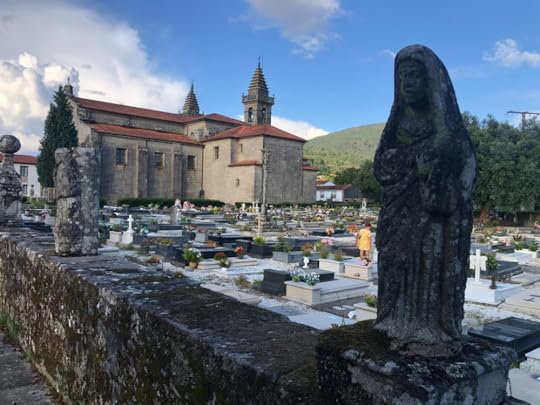
Or cities like this:

Or cute dogs like this:

Or you want to take a selfie like this:
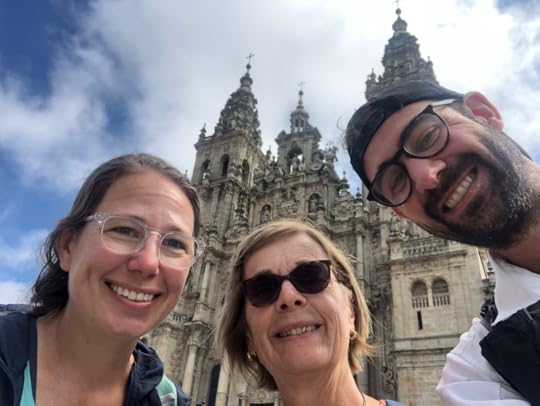 How do I get between Porto and Santiago?
How do I get between Porto and Santiago?First, you get yourself to Porto. Then, you walk north, following the yellow arrows and Camino signs until you get to Santiago de Compostela. Then, you get yourself back home.
,Google Flights or ,Skyscanner will help you find flights. ,Rome2Rio can help you with other transit options.
How long does it take to walk?Once they get to Porto, most people take about two weeks for the whole trip. You can extend or shorten it as much as you’d like. It’s great because it's an epic journey that you can shove into a relatively short vacation. There's also enough here to enjoy for a month or more if you want to take it slow.
If you’re coming from outside of Europe, if you can, I’d allot three weeks including transit to really enjoy the experience.
How should I train?Mostly you should just walk a lot carrying the gear you’re planning to take. Spend at least a few months doing that. If you’re older, injured, or sedentary, spend six months preparing. Seriously. Don’t try to fake it. You’ll get hurt and be sad.
,Here’s a post breaking down my own training process. Have a look. It worked well and it was lots of fun.
Will I need a passport? What about a visa?Yes, you’ll need a passport, unless you’re already in the EU. ,Americans, do yourself a favor and get it now.
As far as visas go, ,if you’re reading this from an English-speaking country, probably not.
Starting in 2024, you will need an ,Electronic Travel Authority for Europe. You can apply online and it’s quick, but do it at least 4 - 5 days before you plan to leave.
How will I know where to go?Start in Porto, go west along the river to the coast, then keep the ocean on your left and you can’t get too far off track.
That’s a bit too simple though. The route is very well marked with signs and yellow arrows most of the way, but you might get off track, particularly in the cities.
You could buy a book with maps if you’re old school. The ,Pilgrim’s Guide by Brierley is solid.
If you’re like the rest of us, just download an app. Either ,Wise Pilgrim or ,Buen Camino. Both have built in navigation tools that you can use to make sure you stay on track.
You can also consult a more comprehensive free online guide, like ,Stingy Nomads.
Where will I sleep at night?Albergues (hostels), hotels, or pensions. There are hundreds of them along the way. Never more than an hour or two walking.
Outside of high season (May - September), you can probably just rock up and book a bed. It’ll be cheap. During the high season, if you try that, you might run into some trouble. Book ahead a day or two. Use ,Booking.com. Most of the options are there and it makes it super easy.
What will I eat on the Portuguese Coastal Camino?Anything you want from the endless stream of cafes, markets, bars and restaurants that you’ll pass the entire way. You’ll never have to walk more than a few hours between services.
I recommend ,francesinhas and chorizo and bocadillos and Padron peppers.
What should I pack?Not much. All that really matters is a good pair of shoes, a comfortable pack, and a functional raincoat. The rest is just details.
,Here’s a post with the exact packing list that my wife, myself, and my 70 year old mom used. (It’s about the Camino Frances but we used the same gear on the Coastal Camino).
How much money should I budget?Once you get on trail, budget about 50 Euros/day for a low rent Camino. Sky’s the limit if you want to stay in private rooms rather than albergues, or want to eat out and drink a lot. If you spend 100 Euros a day, you’ll really be living it up
Will I need cash?Sometimes. Your credit card will work most places (unless it’s American Express) but a lot of cafe’s and some albergues still require cash. Your debit card will work in the ATMs there. There are lots of them.
Make sure you tell your bank and credit card provider that you’re traveling or they may shut down your card and you could be kind of screwed.
What if I need a taxi?In Portugal, ,Bolt is available for a rideshare option in many places, as are standard taxis. In the part of Spain you’ll be traversing (you cross the border about halfway through), there are no rideshare apps. Call a taxi yourself, or ask at a bar or your accommodation for help. Taxis are available literally everywhere on this route. I know because my mom got injured and we had to call them every day to shuttle her ahead.
Buses and trains are also options for a large portion of the route if you want/need to move more quickly than your feet will take you. You’ll sort this out on the ground. Ask at a bar or your accommodation if you want advice.
Can I bike the Coastal Camino instead?Is the Coastal Camino hard?Anything is hard if you make it that way. Walking 174 miles is hard if you aren’t trained and you try to do it quickly. Compared to other Camino routes though, it’s relatively easy. Compared to a proper wilderness hike, it’s very easy.
I’ve heard The Camino is busy. Is the Portuguese Coastal Camino busy?Well, it depends on what you mean. When we did it in the high season, albergues were full and we met plenty of other people along the way. It’s not nearly as crowded as the Camino Frances, and it’s slightly less crowded than the standard inland Portuguese Camino. I didn’t think it felt busy, but you should expect to be walking with others. You're going mostly through populated areas vs. having some kind of solitary wander through the wilderness.
It’s less busy outside of the high season between about May - October.
What’s the weather going to be like?It was perfect for us when we walked in September. Mild, sunny and pleasant every day except for one or two, when it rained a little. Regardless of when you go, prepare for a bit of wind and rain, and mild temperatures.
In Summer, expect 60 - 80 F and sun.
In Autumn, expect 40 - 60 F and a bit of rain.
In Winter, expect 35 - 55 F and rain/cloud.
In Spring, expect 50 - 70 F and a bit of rain.
What season should I walk the Portuguese Coastal Camino?You can walk it any season. It’s a good summer option because the coast keeps temperatures more mild than many of the other Caminos. It is exposed most of the way so in wind and rain it can be kind of miserable, particularly when the temperatures are cool. Allow time to hide from weather if you go in the winter and don’t want to deal with it.
What about language and communication?Don’t worry about it. You’re going to be fine. Learn some Spanish and/or Portuguese if you want to have a better trip, but you can pick up the essentials along the way.
However, you should download ,Google Translate. It helps with both Spanish and Portuguese. It’s a travel gamechanger.
You should also download and set up ,WhatsApp if you haven’t already. They use it a ton in Europe. Some accommodation providers, taxis and tour guides prefer it over normal phone service.
Speaking of phone service, what should I do about that?You can get away with just wifi if you want. They have it in most cafes, bars, and accommodations.
You could also ask your current service provider for international coverage, but that’ll probably be expensive if you’re not already in Europe. You should probably just buy a local SIM card.
Vodafone shops are plentiful. There’s one in the Porto airport, and multiple in Porto city. They’ll help you set it up. Make sure to ask for a prepaid plan that will work in both Portugal and Spain.
Is the Portuguese Coastal Camino worth it?Personally, I loved it. It completely exceeded my expectations. If you like beautiful coastal scenery, picturesque villages, cool old cities, nice beaches, delicious food, easy terrain, and mild weather, you’re going to love it.
I’d do it again in a second.
It was different from the Camino Frances, but it completely stands up as a brilliant travel experience in its own right.
If you’re looking for a wilderness hike, you’re going to be bummed. This is a cultural experience traveling through beautiful coastal scenery, but the Portuguese and Spanish coasts have been populated for millenia.
Otherwise, I can’t think of a single thing not to love.
Is there anything else I should know?Listen, I know there's a lot more to say about this trip.
Honestly though, if you’ve read through this post, you are going to be totally fine. It’s seriously simple. Not easy, but simple. Train. Get to the start. You'll figure the rest out. You’re going to love it.
In the future I will write more posts about each stage to give you a bit more detail. Sign up on the homepage for the mailing list and stay tuned!
For a lot more concise travel truth, read The Dirtbag's Guide to Life .
July 30, 2023
How I Prepared for the Coastal Camino Portuguese using Backyard Adventures.
The Camino de Santiago is a personal pilgrimage, yes, and it’s also a physical, logistical and emotional challenge. None of those things can be separated.
The most elegant way to prepare for that package of things is to replicate the Camino’s elements during the training process. That’s why, for my peak Camino training, I decided to organize a series of backyard microadventures. I didn’t just want to grind out miles, so I went on a five day wandering pilgrimage around Seattle, a place that feels as much like home as anywhere in the world. I incorporated Camino elements to make the training process meaningful, and to prepare myself for what the experience will be like when I get there.
This post is meant to help if you’d like to make your own Camino training something interesting. A pilgrimage in itself, one could say. Or, I guess, if you want to spend a nice week just wandering around Seattle.
 What is the Camino again, in brief?
What is the Camino again, in brief? It’s a little bit confusing, but “the Camino de Santiago” is not actually one trail. It is a network of at least 281 routes through 29 different countries, all of which converge on Santiago de Compostela, in Galicia, Western Spain. Santiago was one of Medieval Europe’s most important pilgrimage sites, and in recent decades there’s been a significant revival in interest in the routes, and hundreds of thousands of people complete some stretch of official Camino every year.
In 2013, my wife and I completed the ,Camino Frances - the most popular route crossing from Western France to Santiago. This year we decided to go back with my mom for her 70th birthday, and complete the ,coastal route of the Portuguese Camino, starting in Porto and covering around 174 miles between there and Spain. I was in great shape last Camino. This time I’m a decade older and a lot less fit, so I needed to be more intentional about my training. I also wanted to enjoy the process, so I decided to put together a strategy that accomplished the most important goals in any Camino training program:
Physical fitness Emotional preparation Building confidence Testing gear Replicating Camino conditions Having a meaningful experience in training. Enjoying the processIt’s fine to be pragmatic, but why not enjoy yourself along the way? Why not let the lessons at home carry over to the experience abroad? Why not burn some of the Camino experience into your everyday life?
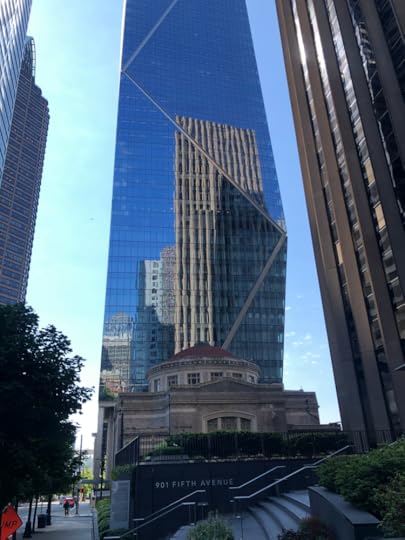 A Portuguese Camino Training Program via Local Microadventure
A Portuguese Camino Training Program via Local MicroadventureThe Camino is a ramble through European countryside along routes that pilgrims have been walking for thousands of years, and it’s easy to romanticize. (That’s fine - romanticize away!) However, walking long miles every day for weeks on end really is hard. It exposes you to the possibility of trip-ruining overuse injury, hypo- and hyper-thermia, blisters, strains, and misery. Plenty of people jump in and survive without intentional training, but you really do want to have a baseline level of fitness to ensure that you have the best experience possible.
What is the Portuguese Coastal Camino specifically?It’s known as one of the more accessible routes. It’s not short, but it’s also not insanely long. It’s not totally flat, but there are also not a lot of big hills. It’s meant to be very beautiful - one of the nicest Camino routes. There are plenty of hostels (called albergues) and restaurants so you don’t have to stress about food or accommodation. It’s a lot less busy than the Camino Frances but it’s popular enough that you’ll meet plenty of other pilgrims along the way. The route is set, but it’s also customizable and you can jog over to the more traditional inland route of the ,Portuguese Camino if you want, or add on the ,Spiritual Variant, which is meant to be the origin of all the Caminos. It features a mix of terrain, walking through cities, towns, countryside, and along beaches and coast. In September when we scheduled our trip, it will be quite comfortably warm, with temperatures in the 70s and 80s Fahrenheit. We have 16 days, so we have to be fit enough to walk 10 - 15 miles a day factoring in a rest day or two. In short, it’s very much doable, but you still need to train.
Reasonably enough, most people prepare for the Camino by following a hiking or walking program. Personally, I enjoy running, and it’s a shortcut to fitness that’s easier to integrate into day to day life for me. So about five months before our scheduled Camino, I started working through a 16 week ,half-marathon training program. It’s nice to have a basic structure, and that got us roughly to where we needed to be a month out from our trip.
That’s the boring bit though. The fun part was that, after completing the half-marathon training, about three weeks before our trip, I put together a series of 4 - 6 hour walking adventures through Seattle.
What you need to plan forWhen you’re trying to create an experience that will prepare you for the Camino, the things you need to think about are pretty much the same as on the trip itself:
Timeframe Daily distances Location Transportation Accommodation Safety Food Gear ClimateFor my approach, I wanted to have the experience of multiple back to back days going distances similar to the Camino, without breaking myself. So, I walked between 10 and 15 miles every day, hung out with friends along the way, and generally built my own little mini-pilgrimage within the city. I wanted it to be a nostalgia trip as well as a nice urban hike, so I visited a mix of new places and old haunts.
Each day I tried to hike in the heat to replicate Portuguese coastal conditions as much as I could. The weather mostly cooperated - it didn’t rain at any point so I didn’t get that experience, but I did get plenty of heat and sun, which was good. I carried the rough equivalent of the gear I’ll take on the Camino, and tested out two pairs of shoes on various types of terrain (I wanted to choose between Brooks Ghosts vs. Brooks Cascadias). The route was primarily sidewalk but I was also able to work in a significant amount of trail and even a bit of sand at the beach. Seattle’s a hilly city, but I didn’t go out of my way to find extra hills because the Portuguese Coastal Camino is relatively flat. I went alone, but spent one day walking a very busy loop at Greenlake to replicate the experience of walking in a crowd similar to the one heading into Santiago. I bought food and found water along the way, and slept in unfamiliar (although not unpleasant) environments at friends’ houses, basing myself first in South Seattle, then later at a different friend’s place in the north. I often used public transit to get between the start and finish of my days, but for half of the days I walked straight out the door and got on my way. Seattle’s a safe city, but so are the vast majority of places in the world if you stick to wandering during the day. I didn’t do any night walking, but I don’t plan to do that on the Camino either.
Daily breakdownSeattle’s a great walking city so you could do a lot of things with a trip like this. I’m a relaxed guy so I didn’t spend energy organizing a formal route. Instead, I decided to approach it according to the model of wandering pilgrimage. It’s not what the Camino is, but it’s a time-honored style of travel: pick a location that’s important to you, wander around for days, and see what happens.
How did I decide where I’d wander, specifically? I found transit hubs (light rail stations, normally) and walked between places I wanted to visit. I knew where I’d start and finish, but not where I’d go in between. I made sure to walk at least 4 hours (not including breaks) to get in the miles. On the final day I walked a set circuit, but I didn’t decide on that until the day before I did it. In short, I followed my heart.
Here’s a snapshot of what each of my days looked like, with some very brief notes about whatI took away from each of them.
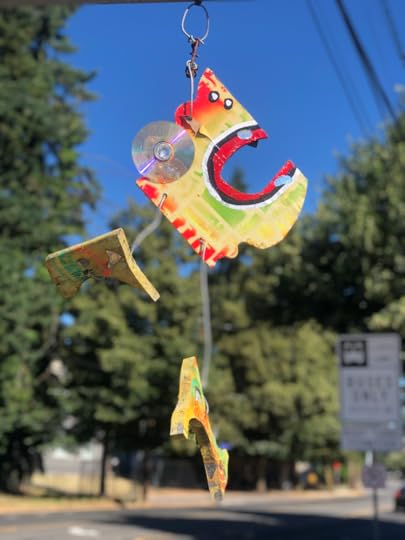 Day 1: Melting Pot Seattle
Day 1: Melting Pot SeattleMy route on the first day involved walking out our friend’s door in the south of the city and towards downtown through the Rainier Beach, Columbia City, Rainier Valley, Central District and Capitol Hill Neighborhoods. In Seattle, like a lot of places, the most legitimately interesting parts of the city are the suburbs. On my way to downtown, I wandered past African markets and Mexican groceries and Vietnamese restaurants and Ethiopian Orthodox churches. It’s a part of the city that I’m not sure I’ve connected on foot before. Seattle has a reputation as a homogeneous city but ,this is the most diverse part, and it felt like it. Until I got to Capitol Hill, the neighborhoods felt very international. On the bus back, I was the only white guy, as far as I could tell, which is an unusual experience in central Seattle.
What did I get from this? On Day 1, I took away a sense of being out of my element. It’s the thing I like about the city. You could be anywhere in the world.
Day 2: Tourist-facing Seattle
Today I immersed myself in the Seattle that tourists see. I walked to the light rail station and took it to Pioneer Square, the oldest part of Seattle. I walked to the spectacular Central Library, through downtown and along the piers and waterfront parks. Then I made my way through the Queen Anne neighborhood to maybe the most famous view of the city at Kerry Park. I worked my way back through South Lake Union - a neighborhood entirely dominated by Amazon - and back downtown through the Pike Place Market.
What did I get on Day 2? You have to find the sacred in the profane. Based on my previous Camino, one thing about pilgrimage is that everything seems normal at the time you experience it, but some experiences you’ll look back on as life-changing. Wandering through tourist traps keeps you from getting too high minded. It keeps you grounded in reality in a way. Some day maybe I’ll look back on this as important?
 Day 3: My Seattle
Day 3: My SeattleI rode the train on Day 3 to Capitol Hill, which is my Seattle. This is the neighborhood where Angel and I lived in for 13 of the most important years of our life. It’s where I became an adult, really. My route took me from there to the University District, where both Angel and I studied, and near the hospital where I worked for a decade. It was a nostalgia trip, but I also visited Bruce Lee’s grave, where I’d never been, and some of Seattle’s most pleasant parks: Volunteer, Interlaken, the Botanic Gardens, and the Center for Urban Horticulture. I finished with a walk through the University of Washington Campus, sneaking in to the ,Suzzalo Library, one of the most spectacular buildings on the West Coast.
What did I get out of this? While Capitol Hill is one of those great, busy, eclectic neighborhoods that all cities have, today was actually a bit more tranquil than the last two days because I spent so much time in the parks. I’m a nostalgic kind of guy, so I basked in old memories and reflections about the way that Seattle has shaped me through the years. This experience is different from the strange world you enter when you travel to walk the Camino. It’s the familiar world, but I was doing something strange there, just wandering around.
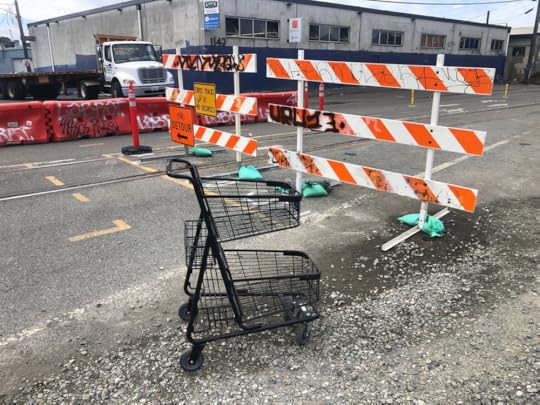 Day 4: The quirky, sprawling old suburbs.
Day 4: The quirky, sprawling old suburbs.I took a couple of days off, and we shifted our base to the northern part of the city. When I started back, I left from our friend’s house in north Ballard and made a loop, walking to Fremont, and the famous Troll and Vladimir Lenin statues. Then I walked along the Burke-Gilman trail - a bike path that I’ve run or ridden a hundred times - through Golden Gardens, up to Carkeek Park, then back home.
What was this day? Today was a confronting mix of things. Fremont and Ballard are quirky, wealthy parts of the city. They’re neighborhoody and pleasant. There are also a striking number of people sleeping on the streets. That is true in a lot of the city, but the contrast is notable here between the sprawling, expensive old suburbs and the hordes of people living in parking lots in tents and ruined RVs. This is the US. It’s a value of walking. You see things on foot that you don’t in a car.
 Day 5: Circling the Lake
Day 5: Circling the LakeOn my last day, I walked a mile and a half to Greenlake, circled it three times, then walked back. Why? I wanted an experience of being in a crowd because that’s often what the Camino is like. Also, walking around things is a classic pilgrimage ritual. Muslims circle the Kaaba seven times on Hajj. Buddhist pilgrims circle sacred sights as a way to honor them. The practice even has a name - circumambulation. I figured it’d be a good way to conclude this little journey. Greenlake is a pleasant, leafy park that’s always heaving with locals. There’s a classic 5k loop that people jog or walk as part of their daily routine. It’s one of Seattle’s beating hearts, especially on a nice summer day. It’s a perfect place to circumambulate.
What did I get from Day 5? A sense of flow that comes along with not having to think about route choice. I thought i’d find the crowd at Greenlake overwhelming but it was actually the most pleasant, stress-free day of the entire experience. I had that thing where you lose track of time, and drift off into your thoughts. Between loops 2 - 3 I forgot how far I’d gone, and I was sad when it was over, which I didn’t expect. Part of it might have been the sense that I was going along with the flow of the crowd. I expected not to see the same faces each loop, but some people were there as long as I was getting in their runs or workouts. There’s an image of pilgrimage as an individual journey, but there’s something magical about walking along in a crowd that’s headed in the same direction.
It felt like an appropriate way to end this little experience, and bridge over to joining thousands of other pilgrims on the Camino.
TakeawaysGoing in to this experience, my goals were to make sure I felt physically fit for the Camino, test out my gear and my fitness, spend some time in the sun, and have a bit of a pilgrimage experience in a place that I know very well. I wanted to ,test my own theories, and have an unusual experience in a familiar place.
I came away with a lot that was practically valuable. It was a nice reminder of what it’s like to spend multiple days in a row walking through civilization, on varying surfaces, and adjusting on the fly. It got me out into a bit of heat and sun (although Seattle’s not exactly balmy). It allowed for a lot of reflection, boredom, and fun - just like a real Camino. I got sore feet, but slightly less so in the Ghosts than the Cascadias, so it helped me make my shoe decision. It confirmed that my pack will work, which wasn’t a huge surprise. It helped me accept the fact that I’m going to be sore and tired, even if we’re ‘just’ going to be walking 10 - 12 miles a day. It also was a reminder that 10 miles a day is much easier than 15 or 20.
It was also a confirmation that intention matters. Just by saying, “I’m going to think about home on this walk,” I reflected a lot about the role that Seattle’s played in my life thus far, which made the experience meaningful. It’s not my goal with this article, but I’ll probably write up my more internal, narrative reflection at some point. (,Join the mailing list on the home page and I’ll let you know when I do!)
What were the challenges?Frankly, there weren’t any major challenges, which reassures me that this sort of experience is a great idea for people preparing for a walk like the Camino.
I did learn that trail runners on city streets aren’t the best option. Navigating transit took up a lot of time but keeping the walks to 4 - 6 hours meant that wasn’t a major problem. I completed my 5 days across a week with a two day break in the middle, but you could organize something similar across three weekends to similar effect, or do some of the walking after work if you’re 9-5 like most normal humans.
What are the key things to know if you want to replicate this experience in your own area?This is kind of anticlimactic, but it’s true - just do it. Organizing a wander really doesn’t have to be that hard. There is something nice about just walking out the door and deciding where you’ll end up on the fly. Some places are more amenable to this sort of thing than others, of course, and if you don’t have access to transit you might think about loops or out and backs from your house or your car. The experience didn’t feel like training, and felt like an experience itself. It prepares you naturally for what the Camino will be.
For another, more hardcore example of this sort of thing, check out this article on a friend’s 300 mile Portland Thru-hike .



